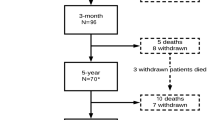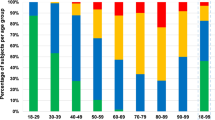Summary
The clinical findings and operation results in two series of patients with medial prolapse of an intervertebral disc with total or partial occlusion of the spinal canal are reported. In one of the series (30 patients) symptoms of cauda equina compression, with bladder and rectal disturbances, were present, and in the other series (28 patients) these symptoms were absent. The observation period was five years (median value). The late results are evaluated in relation to the time interval between the onset of symptoms and operation. In the series with caudal compression syndrome, sphincter disturbances persisted in 10 patients, six of whom underwent operation during the first week after the onset of symptoms. The prognosis was most favourable when the symptoms developed slowly. Seventeen patients have returned to work. The importance of early operation in patients with classical compression syndrome of the cauda equina is emphasized.
In the series without caudal compression syndrome, the symptomatalogy varied. The duration of symptoms was strikingly long. Only 19 patients are able to work. The others are prevented from working by persistent backache and leg pains, and in four cases by pareses of the extremities. In these cases also the importance of early operation is stressed.
Similar content being viewed by others
References
Hübner, K., Die Indikation zur Operation des lumbalen Bandscheibenvorfalls. Dtsch. Gesundh.-Wes.20 (1965), 893–895.
Jennett, W. B., A study of 25 cases of compression of the cauda equina by prolapsed intervertebral discs. J. Neurol. Neurosurg. Psychiat.19 (1956), 109–116.
Jochheim, K. A., Loew, F., Rütt, A., Lumbaler Bandscheibenvorfall. Konservative und operative Behandlung. Berlin-Göttingen-Heidelberg: Springer. 1961.
Knudsen, V., Sphinctersymptomer ved lumbal discusprolaps. Ugeskrift for laeger.129/30 (1967), 961–965.
Kuhlendahl, H., Hensell, V., Nil Nocere, Schäden bei „Wirbelsäulen-Reposition“ in Narkose. Münch. med. Wschr.100 (1958), 1738–1739.
Lenz, R., Die total in den Wirbelkanal ausgestoßene Bandscheibe. Dissertation (1956) aus der Neurochirurgischen Klinik der Universität Köln.
O'Conell, J. E. A., The indications for and results of the excision of lumbar intervertebral disc protrusions: A review of 500 cases. Ann. Roy. Coll. Engl.6 (1950), 403–412.
Paillas, J.-E., Grisoli, F., Roche, D., Sciatiques paralysantes. Etude d'une nouvelle série opératoire de 84 cas (1958–1974). Sem. Hop. Paris52 (1976), 1145–1150.
Shephard, R. H., Diagnosis and prognosis of cauda equina syndrome produced by protrusion of lumbar disc. Brit. Medical J.2 (1959), 1434–1439.
Thaher, Y., Sorour, O., El-Shafie, I., Elwan, O., Samra, D., Cauda equina lesion due to prolapsed lumbar intervertebral discs. J. Egypt. med. ass.49/5–6 (1966), 336–346.
Author information
Authors and Affiliations
Rights and permissions
About this article
Cite this article
Spännare, B.J. Prolapsed lumbar intervertebral disc with partial or total occlusion of the spinal canal. Acta neurochir 42, 189–198 (1978). https://doi.org/10.1007/BF01405333
Issue Date:
DOI: https://doi.org/10.1007/BF01405333




